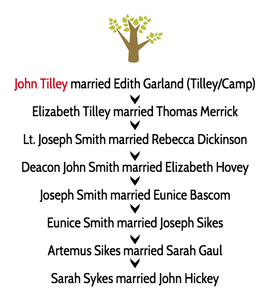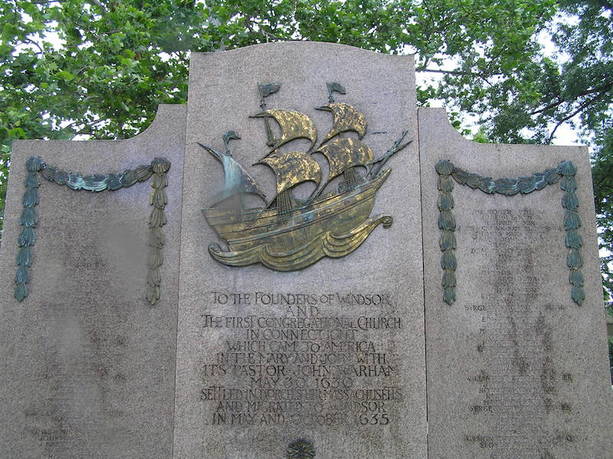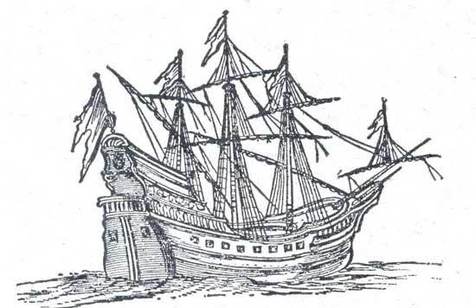|
Of all the places my ancestors supposedly came from, no one in my family ever talked about Windsor, CT., recognized as the first settled town in the state. My mother traced her Maine ancestry lines back to the Massachusetts Bay Colony, largely to Cape Cod. My aunts had done some genealogy research back in the 1960s but they had traced back through the paternal lines only. Exploring the maternal lines of kinship in our family back more than ten generations I found hundreds of people who now populate my tree. Among them was Sarah Ann Sykes, a wizened little old lady in this photograph taken of her around the turn of the century. Sarah Sykes, it turned out, had been overlooked in the search for Yankee ancestors because, in 1843, she married John Hickey, an Irish Catholic immigrant, and dropped her Protestant faith to assume that of her husband. Her line, traced back from Bristol, Maine to the Pioneer Valley of Massachusetts and to Windsor, Connecticut, revealed dozens of 17th-century ancestors. Their stories revealed a constant migration that took them from Dorchestor, Massachusetts to Windsor, Connecticut then onto Springfield, Northhampton, Belchertown and beyond, fulfilling God’s command to “Go forth and multiply.” Our Ancestors in Windsor
 John Dumbleton married into the Marshfield family, but only after Thomas had disappeared. Dumbleton came to the Connecticut colony as an indentured servant to William Whiting of Hartford, one of the richest and most powerful men in the area, in 1638. For much of his seven-year indenture, Dumbleton worked a piece of Whiting’s land in Windsor that he later testified about: “There was little improvement on the land when I came upon it, but I plowed and brake up considerable quantity of it." When his indenture ended in 1645, Dumbleton leased the land for farming. Around 1649, Dumbleton migrated to Springfield along with the remaining members of the Marshfield family, a group that included daughter Mercy whom he married either just before or after their relocation to Springfield. Thomas Ford and Aaron Cooke Thomas Ford was a well-endowed 45-year-old when he came to the Massachusetts Bay Colony on the Mary and John ship in 1630, inspired by the Puritan teachings of Reverend White of , Dorchester, England. . His 14-year-old stepson, Aaron Cooke was with him, along with his second wife, Elizabeth Charde, and nine more children. One year after he arrived, Thomas became a freeman in Dorchester, Massachusetts, and Aaron Cooke followed in 1635. Like virtually all settlers in the Dorcestor plantation, the Fords were farmers and in 1636 they headed out with Reverend Warham's congregation to settle in Connecticut. In the new plantation, Cooke married his half-sister, Mary Ford. Her father, Thomas, filled many leadership roles, including on the jury of the General Court of Connecticut. Aaron became a captain in the local militia, in charge of training, and he was appointed commander-in-chief of a company formed to go against the Dutch who were still defending their claims on the Connecticut river. He also served several times on the jury of the General Court. Mary died in 1645 while giving birth to her fourth child. Her second son, Aaron, Jr., born in 1641, is my direct ancestor. Aaron, Sr., remarried three more times before his death. He worked some of his Thomas Ford’s 50 acres in Simsbury, Ct. (Massacoe), then received his own land grant in Northhampton, Massachusetts and moved there in 1660. Aaron Cooke, Jr. went to the same area and in May 1661 he married Sarah Westwood in Hadley, Ma. Ephraim Huit  He lived only six years in Windsor but Reverend Efraim Huit was a well-known Puritan in England, where he was stripped of his position because of views that were heretical to the Church of England. You can read more about Huit’s life in England in this excellent piece by genealogy blogger Janice Harshbarger here. Huit led a group of half a dozen families to join Reverend Warham in Windsor in 1638-9 and he became the congregation’s teacher. Remnants of some of his sermons have been preserved, including twenty-two based on the teachings of Timothy. His treatise on the Prophecies of Daniel was published shortly before his death. In Windsor, Huit undertook the task of building a new meeting house. He designed the structure and raised 200 pounds for its construction, borrowing most of the funds from wealthy Hartford resident George Wyllys. The loan was repaid with proceeds from a corn mill that had been donated to Huit and Warham by the congregation. The meeting house was completed in 1641 and Huit died three years later. Twelve years after his death.his daughter, Lydia, married a 19-year-old, Joseph Smith, who would be included in this story if he had lived in Windsor instead of nearby Hartford. John Tilley  John Tilley came to live in Windsor for economic opportunity, no doubt. Tilley was a sea captain and a fisherman who arrived in New England in 1624, before the Massachusetts Bay Colony had been founded and shortly after the Pilgrims landed in Plimouth. He was part of a group led by Robert Gorges to Cape Ann, where Tilley oversaw a failed effort to start a fishing venture. He followed Roger Conant to a new settlement that was renamed Salem in 1628. Sometime after the arrival of Governor Winthrop and the establishment of the Bay colony in 1630, Tilley removed to the new plantation of Dorchester. Tilley was captaining the ship Thunder to Bermuda in 1633 when he was sued for debt by his partners. It is recorded that just before he died in October 1636, Tilley was delivering letters from Governor Winthrop to Old Saybrook, sailing in the mouth of the Connecticut River. The Governor later described what happened: About the middle of this month, John Tilley, master of a bark coming down the Ct. River, went on shore in a canoe three miles above the fort (Saybrook) to kill fowl and having shot off his piece, many Indians arose out of the covert and took him and killed one other who was in the canoe. This Tilley was a very stout man and of great understanding. They cut off his hands and sent them before and after cut off his feet. He lived three days after his hands were cut off and themselves confessed that he was a stout man, because he cried not in his torture.” Tilley’s widow, Edith, lived in Windsor, where the couple had moved with the others who moved from Dorchester earlier that year. Their daughter, Elizabeth, who was four years old, grew up to marry Thomas Merrick, another Sikes ancestor. Richard Oldage  Most of my Windsor ancestors were well-known but Richard Oldage and John Osborn left little in the historical record. Richard Oldage was about 40 years old when he came to Windsor from England in 1639, part of the group led by Reverend Ephraim Huit whose non-conformists beliefs led him to seek the Puritan plantation. By 1640 Oldage owned land that stretched for three miles on the east side of the river, as well as land on the west side, the heart of the plantation. The only official record I found stated that in 1656 Oldage was appointed by the Connecticut General Court to be a “leather sealer,” an office that required him to give his stamp of approval on leather goods that he inspected, tested and certified. When Oldage died, his daughter Ann, my direct ancestor and his only child, inherited that land. By then, she had been married for about fifteen years to John Osborne. John Osborne Little can be found in the record about John Osborne, who was born in either England or Wales in 1621. His father’s name has not been verified, but in his will he signed his name John, Senior, indicating that he was not named after his father. John Osborne’s name is listed as a founder of Windsor, Connecticut, a status given to any male settler who arrived by 1641. John would have been 20 that year and it is unlikely that he would have been given any land grant at that age. He may have come to Windsor as a tradesman, but the historical record has not turned up any evidence of his occupation outside farming, which all settlers practiced by necessity. The historical record is contradictory about his wedding date. They agree that the marriage occurred on May 19 in Windsor, but it is recorded as 1643, ‘44 and ‘45. His wife, Ann Oldage, inherited her father’s extensive land holdings, about 1,000 acres, after his death in January 1659/60. John Osborne became a freeman of the church in 1669, a year after my direct ancestor, Sarah Osborne married Lt. Abel Wright and removed to Springfield, Massachusetts, leaving her Windsor family behind. Benedictus and Joanne Alvord  Benedictus Alvord is remembered as a founder of Windsor, having arrived their shortly after he sailed from England at age 11 with his brother and sister, Alexander and Joanne. Joanne is my direct ancestor but Benedictus’ role in history cannot be overlooked. He was a sergeant at age 18 in the 1637 war against the Pequots, when hundreds of natives, mostly women and children, were massacred when the soldiers set their homes on fire and sealed the exits. Benedictus Alvord returned to England the next year and married. His bride was a passenger on the ill-fated ship charted by Thomas Marshfield in 1640 and Alvord sued Marshfield for ten pounds. In Windsor, Benedictus prospered, serving as a juror, then as constable in 1666. He passed away April 23, 1683 in Windsor, Hartford, Connecticut.
Joanna (Jane) Alvord, his sister, married Ambrose Fowler, who did not appear in Windsor until 1640, when he was 14. By age 19, he and Joanna were parents. The family stayed in Windsor at least another 18 years, then removed to Westfield, Massachusetts, where their eldest daughter married Increase Sikes, great-great-great-grandfather of Sarah Sykes.
5 Comments
Don Duncan
7/9/2018 09:06:32 am
Great insight on people and I am wondering about some of your research. Aaron Cooke-1640/41 is also my direct ancestor (9th great grandfather) and I have seen conflicting reports on his birth:
Reply
Nancy Peckenham
7/10/2018 03:35:31 pm
Hello Don and thanks for your encouragement. Your comment prompted me to look into Mary Cooke and discovered that her identity as the daughter of Thomas Ford has been challenged. One link says 'newer research says she was MARY COOKE, daughter of William and Martha (White) Cooke.' https://wc.rootsweb.ancestry.com/cgi-bin/igm.cgi?op=GET&db=sanford-shulsen&id=I10919
Reply
Don Duncan
7/19/2018 05:05:05 pm
Nancy,
Nancy Peckenham
7/26/2018 12:57:49 pm
Hello, Don. I like the statistical approach you bring to figuring out ancestry and would have to agree that I also favor the Mary Ford hypothesis.
Reply
Don Duncan
8/2/2018 10:50:54 am
Nancy,
Reply
Leave a Reply. |
Names of My AncestorsPuritans & Servants Archives
February 2019
Categories |










 RSS Feed
RSS Feed
